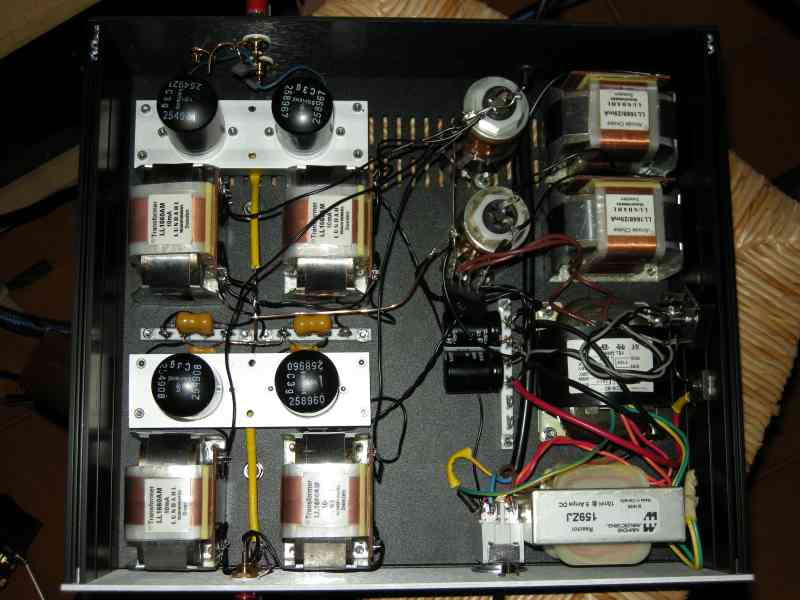|
back
to |
To get more
information contact me at: webmaster@audiodesignguide.com |
Phono End preamplifier
Feb
INTRODUCTION
This project born to be a no compromise phono preamplifier without budget limit.
These are the main characteristics:
Only 2 stages Only
2 vacuum tubes on the signal path No capacitor on the signal path (escluding
RIAA network) No
resistor on the signal path (escluding RIAA network) Less components
of any other design Output
impedance and level to drive any final amplifier without a pre-ampl.
MC input option using a step-up transformer Amorphous core
interstage transformers Passive power supply

COMPONENTS
In
this projects has been used the top of the components like only tantalum
resistors and Silver Mica Radial Capacitor in the RIAA network.
These kind of components are used by AudioNote in the top series production (price about
20000 - 30000$).
The two interstage transformers are amorphous C-core by
Lundahl to
get the best sonic performances.
On cathode the by-pass are good Sanyo OS-CON capacitors considered better than
old ELNA Cerafine and Black Gate.
The power supply use a pair of 100H Lundahl
choke and Jensen AudioGrade
electrolytc capacitors.
This project can be fit in
a normal chassie with height of 80mm like the GX 388 by Hi-Fi2000.
It is possible separate the power supply of each channel using one more 100H
choke.
I have used a single solid copper wire for the ground from the input to the
output llike Mr. Sakuma.
DESIGN
To
calculate the RIAA network I have used the spreadsheet of Fabrizio Marignoni

|
|
The design of
this phono preampl. is very simple, only 13
components per each channel. The C3g is a very low noise pentode, made in
Germary by Siemens. This is a very long life tube, minimum of 10.000 hours. This is a a perfect tube, if it is connected
as triode (g2 -> a, g3 -> k) Ua = 200V, RK =
180 Ohm, Ia = 17 mA, S =
17mA/V, µ = 40, Ri = 2,3 KOhm. In the measurement test I have seen 38Vrms with a distortion of only
1.5%. I have buy the C3g from Classic Components eBay shop. The operation point of the C3g has been the
result of many measurement with the Clio system by Audiomatica. |

I have choiced a passive power supply
For this power supply I have used the R-CORE model R26-90 by DiyClub.Biz with
primaries 2 x 115v and seconaries 0-165v(0.2A) + 2 x 0-9v (1.1A).


For configuring the Lundahl transformers, Jac Music have designed a matrix programmable PCB, which makes it easier to switch between configurations to try things out.

The same Jac Music shop have still a stock of NOS C3g tubes.
MEASUREMENTS
With an input level of 13mV rms we have about 2.1Vrms on output so the voltage gain is 161x = 44dB.



SONIC PERFORMANCES
The result is incredible. I suggest this project only if you have a very good amplifier.
TEST SYSTEM
- Rega Planar 3
- Cartridge SUMIKO BLUE POINT EVO III
- My new 845 Amplifier v2 modified with Lundahl amorphous
- SYNCHESTRA Reference nterconnect cables
- SYNCHESTRA SIGNATURE Speaker Cable
To use the cartridge SUMIKO BLUE POINT EVO III is not necessary the step-up LL1931 because it is a high output level MC.



LISTENING TEST by Ronan Daly
From: Ronan Daly Sent: Thursday, August 19, 2010 5:36 PMSubject: RE:
Hi Andrea,
I compared it with the my Audio Innovation copy using Teflon V-caps and Vishay TX2575 resistors built using the schematic on the Audio Note website using 1 tube (two stages) per channel and no cathode follower so there was a chance to compare V cap capacitor vs transformer interstage coupling. The Audio Note was the best I ever heard up to now beating all the cathode follower units I compared it with. The phono end was however better. The units sounded similar but the phono end had slightly more definition, drums sounded more focused and cleaner sounding. Another listener in his seventies thought your unit was slightly smoother and easier to listen to.
Ronan Daly
PHOTOS


